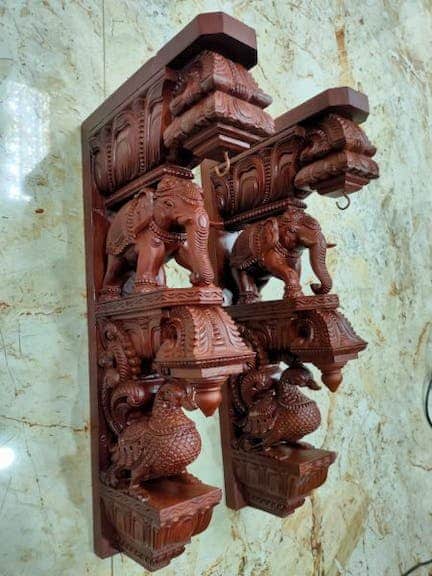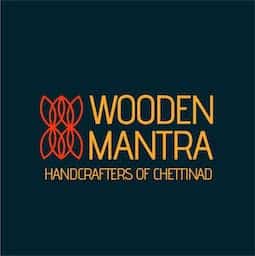If you’re looking for contemporary art that builds on centuries of history, look no further than India’s Clan Wooden Mantra.
We caught up with Lenin Rajaram, whose family is responsible for much of the wooden sculpture in temples in Southern India dating back for centuries.
While maintaining their quality and practices, Lenin now leads their marketing of original teak and other wood sculptures, furniture, & more globally.
He recently integrated Etchings into his transactions to get the benefits of physical NFTs for his art business while avoiding the friction cryptocurrency was causing his buyers. For those unfamiliar with physcical NFTs check out our introductory article “What Is a Physical NFT and How to Use It” on the topic


Lenin, we’ve seen some really beautiful wooden carvings on your ETChster profile. Can you tell us more about what Wooden Mantra creates?
In the early days (before the industrial revolution), we had opportunities to work across all major temples of Southern India. As things were modernized, most of the craftsmen left our style of sculpting to take up odd jobs or just relocated to start over.
Our clan was famous for authentic craftsmanship, so we were able to continue working with temples to this day.
We’ve also since adapted to the changing times by adding to our portfolio. We make traditional handmade furniture, artifacts, sculptures, idols, interior decorations and more based on the knowledge acquired and passed on by our ancestors.
The designs are mostly inspired by the temple works of Tamil Nadu, and we typically use Burmese Teak, Rosewood, or Sandal woods.
Can you tell us a little bit more about your immediate family’s involvement and history?
Wooden Mantra was formerly known as “Vaganapattarai,” and it was founded by my great-grandfather Subban back in the 1800s.
It was part of the royal court of Pudhukottai. Back then we worked for almost all the major temples across South India and Tamil Nadu. Now we have artifacts across temples around the globe (and we wish more of them linked back to us via NFT).
The actual origin of our art form starts 1000 years ago when a Great Indian King named Rajaraja Chola built a temple in Tanjore (which was his capital city).
When the construction of this temple was completed, the rich merchants who lived in Tanjore relocated to a place named Karaikudi and resumed their trade from there. These merchants helped the original artisans relocate to Karaikudi, so the buildings there are as grand as the temples these artisans built back in Tanjore.
We were one of those clans that made that migration.
How about your collectors? Who is buying Wooden Mantra’s creations?
Most of our buyers are from Tamil Nadu or non-residing Indians from across the globe.
Our designs are based on temple and palace work traditions. Some of our customers are trying to set up a traditional home or decorate a pooja room (altar) wherever they live today.
Apart from this we also get orders from art lovers and collectors from different backgrounds and cultures interested in traditional furniture, colonel furniture, wall decor, and other custom artifacts.

How about you, Lenin? What’s your role within the company?
My role in the company is to take this art form and pass it on to the next generation.
I’m doing things like implementing NFT technology for our art so each piece that makes its way around the world is attached to its story and can be attributed to Clan Wooden Mantra by future generations.
When you came across ETChster, you were trying to use crypto NFTs with your collectors…what were you looking to accomplish with NFTs? How were you doing it?
Though my family has been crafting for centuries and what we craft has potential at the global market we never got the credits for the artifacts we made/make.
We got involved with crypto NFTs as a way to be sure that our pieces are differentiated from lower-quality imitations and anyone who comes across our work can find out more and potentially purchase a piece of their own.
It sounds like your collectors weren’t very receptive to crypto NFTs…what were their objections or feedback?
When asked to create a crypto wallet to transfer certifications for proof of ownership, most of our collectors/buyers were not aware of how crypto NFTs work and were reluctant to get involved with cryptocurrency.
That was a problem for us because we couldn’t pass the story of the piece to the new owner.
With ETChster not being crypto-driven, it was easier to transfer Etchings as it was user-friendly and easy to explain. We were able to get our customers to accept the etchings transferred to them without any hassle and now they have a permanent link to our profile and know the story of their pieces.
Are there other ways Etchings fit into your marketing strategy?
We have found it easier to send Etchings versus crypto NFTs. It excites us that our work that is already sold can drive new, direct business for us in perpetuity.
We can grow our connection with collectors directly and avoid brokers and 3rd parties who have tried to take credit for our craftmanship in the past and keep part of the sale price.
Anything else you would like to share?
Thank you! Love, Peace & Understanding.

What’s Next?
Did you:
- Have follow-up questions?
- Have other related thoughts that might be beneficial to the community?
Post them in the comments!
Are You a Visual Artist?
Get the art catalog app and connected, maintenance-free website your art business deserves. Forever Free & Pro versions.
Are You an Art Collector?
You’ll have access to a marketplace of global artists and phenomenal tools to organize your art collection. Forever Free & Pro versions.
You Might Also Enjoy…

Elevating Your Profile: Harnessing the Power of Reviews for Artists

Amplifying Your Art’s Reach: Harnessing the Power of Physical Backlinks

Mastering the Art Sales Funnel: Transforming Strangers into Buyers


